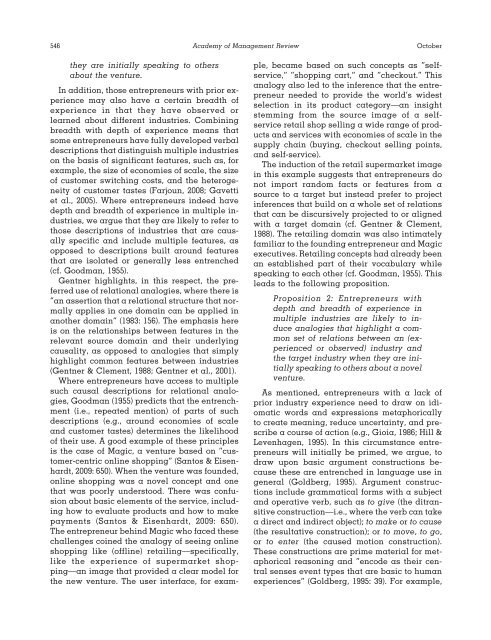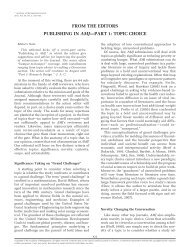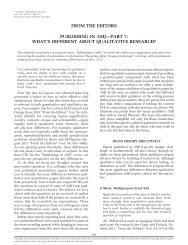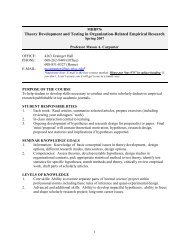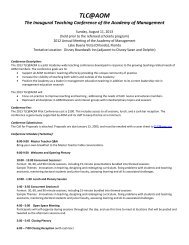inductive reasoning and the creation and justification of new ventures
inductive reasoning and the creation and justification of new ventures
inductive reasoning and the creation and justification of new ventures
You also want an ePaper? Increase the reach of your titles
YUMPU automatically turns print PDFs into web optimized ePapers that Google loves.
546 Academy <strong>of</strong> Management Review<br />
October<br />
<strong>the</strong>y are initially speaking to o<strong>the</strong>rs<br />
about <strong>the</strong> venture.<br />
In addition, those entrepreneurs with prior experience<br />
may also have a certain breadth <strong>of</strong><br />
experience in that <strong>the</strong>y have observed or<br />
learned about different industries. Combining<br />
breadth with depth <strong>of</strong> experience means that<br />
some entrepreneurs have fully developed verbal<br />
descriptions that distinguish multiple industries<br />
on <strong>the</strong> basis <strong>of</strong> significant features, such as, for<br />
example, <strong>the</strong> size <strong>of</strong> economies <strong>of</strong> scale, <strong>the</strong> size<br />
<strong>of</strong> customer switching costs, <strong>and</strong> <strong>the</strong> heterogeneity<br />
<strong>of</strong> customer tastes (Farjoun, 2008; Gavetti<br />
et al., 2005). Where entrepreneurs indeed have<br />
depth <strong>and</strong> breadth <strong>of</strong> experience in multiple industries,<br />
we argue that <strong>the</strong>y are likely to refer to<br />
those descriptions <strong>of</strong> industries that are causally<br />
specific <strong>and</strong> include multiple features, as<br />
opposed to descriptions built around features<br />
that are isolated or generally less entrenched<br />
(cf. Goodman, 1955).<br />
Gentner highlights, in this respect, <strong>the</strong> preferred<br />
use <strong>of</strong> relational analogies, where <strong>the</strong>re is<br />
“an assertion that a relational structure that normally<br />
applies in one domain can be applied in<br />
ano<strong>the</strong>r domain” (1983: 156). The emphasis here<br />
is on <strong>the</strong> relationships between features in <strong>the</strong><br />
relevant source domain <strong>and</strong> <strong>the</strong>ir underlying<br />
causality, as opposed to analogies that simply<br />
highlight common features between industries<br />
(Gentner & Clement, 1988; Gentner et al., 2001).<br />
Where entrepreneurs have access to multiple<br />
such causal descriptions for relational analogies,<br />
Goodman (1955) predicts that <strong>the</strong> entrenchment<br />
(i.e., repeated mention) <strong>of</strong> parts <strong>of</strong> such<br />
descriptions (e.g., around economies <strong>of</strong> scale<br />
<strong>and</strong> customer tastes) determines <strong>the</strong> likelihood<br />
<strong>of</strong> <strong>the</strong>ir use. A good example <strong>of</strong> <strong>the</strong>se principles<br />
is <strong>the</strong> case <strong>of</strong> Magic, a venture based on “customer-centric<br />
online shopping” (Santos & Eisenhardt,<br />
2009: 650). When <strong>the</strong> venture was founded,<br />
online shopping was a novel concept <strong>and</strong> one<br />
that was poorly understood. There was confusion<br />
about basic elements <strong>of</strong> <strong>the</strong> service, including<br />
how to evaluate products <strong>and</strong> how to make<br />
payments (Santos & Eisenhardt, 2009: 650).<br />
The entrepreneur behind Magic who faced <strong>the</strong>se<br />
challenges coined <strong>the</strong> analogy <strong>of</strong> seeing online<br />
shopping like (<strong>of</strong>fline) retailing—specifically,<br />
like <strong>the</strong> experience <strong>of</strong> supermarket shopping—an<br />
image that provided a clear model for<br />
<strong>the</strong> <strong>new</strong> venture. The user interface, for example,<br />
became based on such concepts as “selfservice,”<br />
“shopping cart,” <strong>and</strong> “checkout.” This<br />
analogy also led to <strong>the</strong> inference that <strong>the</strong> entrepreneur<br />
needed to provide <strong>the</strong> world’s widest<br />
selection in its product category—an insight<br />
stemming from <strong>the</strong> source image <strong>of</strong> a selfservice<br />
retail shop selling a wide range <strong>of</strong> products<br />
<strong>and</strong> services with economies <strong>of</strong> scale in <strong>the</strong><br />
supply chain (buying, checkout selling points,<br />
<strong>and</strong> self-service).<br />
The induction <strong>of</strong> <strong>the</strong> retail supermarket image<br />
in this example suggests that entrepreneurs do<br />
not import r<strong>and</strong>om facts or features from a<br />
source to a target but instead prefer to project<br />
inferences that build on a whole set <strong>of</strong> relations<br />
that can be discursively projected to or aligned<br />
with a target domain (cf. Gentner & Clement,<br />
1988). The retailing domain was also intimately<br />
familiar to <strong>the</strong> founding entrepreneur <strong>and</strong> Magic<br />
executives. Retailing concepts had already been<br />
an established part <strong>of</strong> <strong>the</strong>ir vocabulary while<br />
speaking to each o<strong>the</strong>r (cf. Goodman, 1955). This<br />
leads to <strong>the</strong> following proposition.<br />
Proposition 2: Entrepreneurs with<br />
depth <strong>and</strong> breadth <strong>of</strong> experience in<br />
multiple industries are likely to induce<br />
analogies that highlight a common<br />
set <strong>of</strong> relations between an (experienced<br />
or observed) industry <strong>and</strong><br />
<strong>the</strong> target industry when <strong>the</strong>y are initially<br />
speaking to o<strong>the</strong>rs about a novel<br />
venture.<br />
As mentioned, entrepreneurs with a lack <strong>of</strong><br />
prior industry experience need to draw on idiomatic<br />
words <strong>and</strong> expressions metaphorically<br />
to create meaning, reduce uncertainty, <strong>and</strong> prescribe<br />
a course <strong>of</strong> action (e.g., Gioia, 1986; Hill &<br />
Levenhagen, 1995). In this circumstance entrepreneurs<br />
will initially be primed, we argue, to<br />
draw upon basic argument constructions because<br />
<strong>the</strong>se are entrenched in language use in<br />
general (Goldberg, 1995). Argument constructions<br />
include grammatical forms with a subject<br />
<strong>and</strong> operative verb, such as to give (<strong>the</strong> ditransitive<br />
construction—i.e., where <strong>the</strong> verb can take<br />
a direct <strong>and</strong> indirect object); to make or to cause<br />
(<strong>the</strong> resultative construction); or to move, to go,<br />
or to enter (<strong>the</strong> caused motion construction).<br />
These constructions are prime material for metaphorical<br />
<strong>reasoning</strong> <strong>and</strong> “encode as <strong>the</strong>ir central<br />
senses event types that are basic to human<br />
experiences” (Goldberg, 1995: 39). For example,


